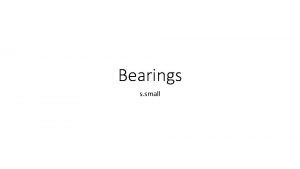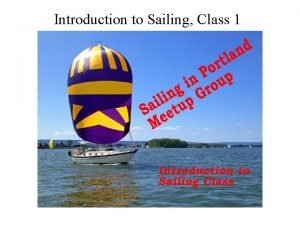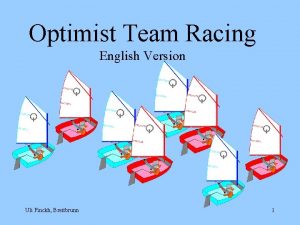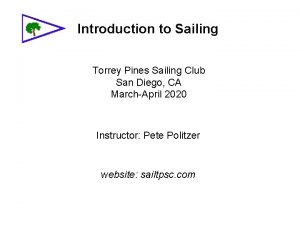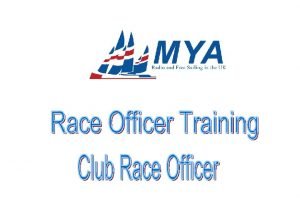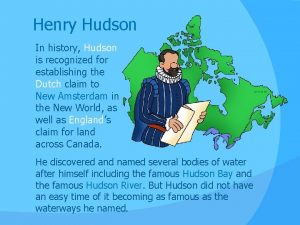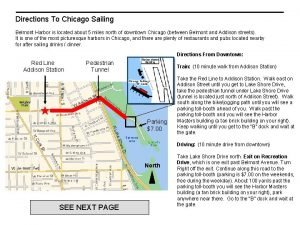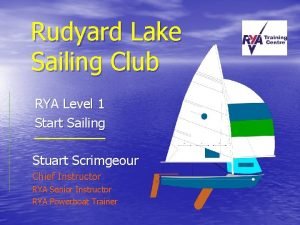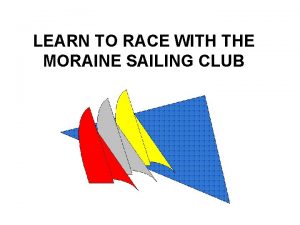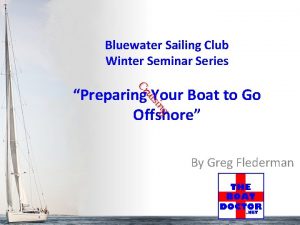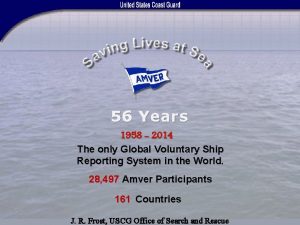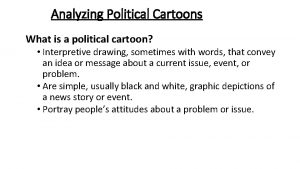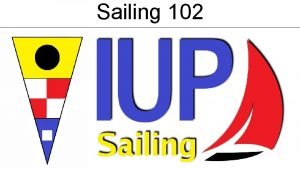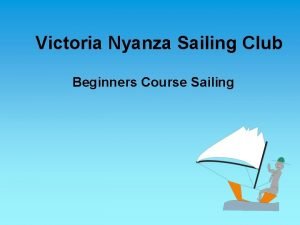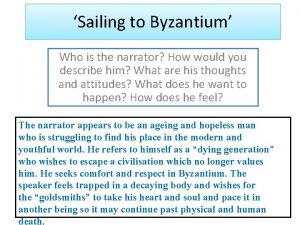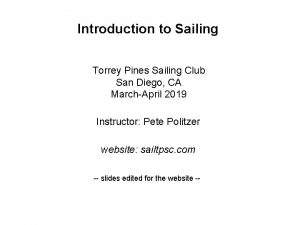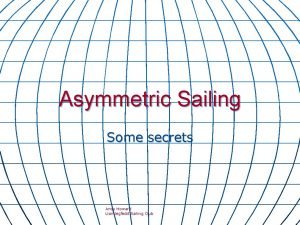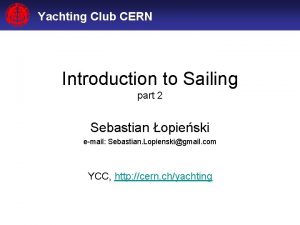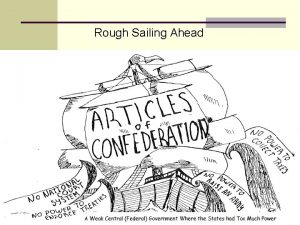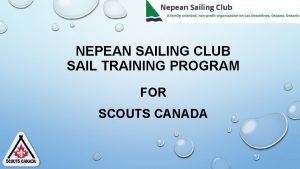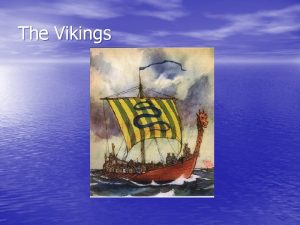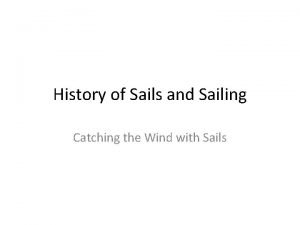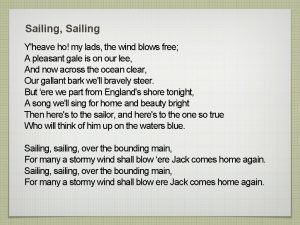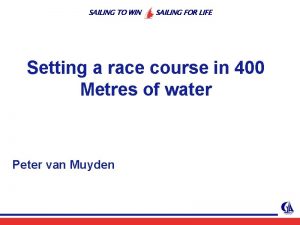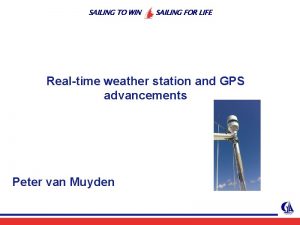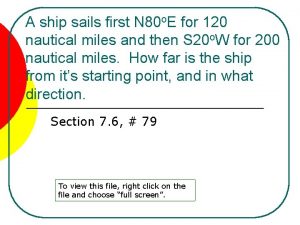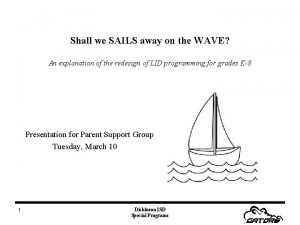The Physics of Sailing Outline Hulls Keels Sails


































































- Slides: 66

The Physics of Sailing

Outline • Hulls • Keels • Sails

Hulls • • “Hull Speed” Resistance Shape Stability

Hull Speed • Hull speed is determined by the length of the boat. • Water waves are dispersive, i. e. , their speeds depend on the wavelength of the wave; long wavelengths are faster. • Boats generate a wave at the bow. The speed of this wave must equal the speed of the boat. (This is the speed with which the crest is being forced to advance. )

Hull Speed • At first, the boat moves slowly and the bow waves generated have short length; several waves are seen along the side of the boat. • As the boat moves faster, the wavelength increases, until it equals the length of the boat. • When the wavelength becomes longer than the boat, the stern begins to fall into the trough of the wave and the boat is ploughing “uphill” on the bow wave. • The resistance increases dramatically.












HULL RESISTANCE • Surface Resistance Shearing • Turbulence Reynolds No. • Eddies Separation • Shape

Friction: Intermolecular forces



Roughness • Hull should be “smooth”. Bumps will introduce turbulence sooner and/or will produce larger turbulence. • “Polishing” does not help very much. Shearing must take place!


Hull Shape (Form Resistance) • Hull shape determines how fast a boat can accelerate and how fast it can go in “light’ winds. • Generally speaking, narrower, shallower hulls are faster, but less stable and hold less “cargo”. • Exact shape for fastest hull is still a subject of debate.



Modern Racing Hull Design • Narrow, sleek bow • Shallow, flat bottom toward stern • Square stern, normally above water line • Able to plane under certain conditions



Keels • Keels are necessary to provide resistance against “side-slipping”, and to provide counter balance for sideways force of wind on sails. • A large keel adds a lot of surface resistance. • Want a balance between positive keel action and negative keel resistance.


Wing theory • Keels and sails act like airplane wings; i. e. , they can provide “lift”. • Proper design helps a lot!

Lift (Bernoulli’s Principle) ↑


Sail and Keel Lift



Fluid flow around wing





Typical Cruising Keel

Racing Keel

Shallow draft keel with wing

Keels and Stability



Sails • Sails provide the power. • Sails act like wings and provide lift and generate vortices. • Ideal sail shape is different for downwind and upwind: Downwind sails should be square-shaped (low aspect ratio). Upwind sails should be tall (high aspect ratio) to minimize vortex generation.


















 Clark hull drive theory
Clark hull drive theory Hulls landing
Hulls landing Linea alba protrusion
Linea alba protrusion Andy keels
Andy keels Sails information literacy
Sails information literacy Ultralight sails
Ultralight sails The bearing of a ship from a lighthouse is 050
The bearing of a ship from a lighthouse is 050 Ship with butterfly sails (1937) meaning
Ship with butterfly sails (1937) meaning Sentence outline example
Sentence outline example Simple physics ia ideas
Simple physics ia ideas Why does it happen
Why does it happen University physics with modern physics fifteenth edition
University physics with modern physics fifteenth edition Metaphors for sailboat
Metaphors for sailboat Meetup sailing
Meetup sailing Uli finckh
Uli finckh Small loop
Small loop Soggy paws sailing
Soggy paws sailing Sandusky sailing club
Sandusky sailing club South sound sailing society
South sound sailing society The adventures of odysseus summary
The adventures of odysseus summary Trapezoid sailing course
Trapezoid sailing course Sailing from troy
Sailing from troy Gpsmap 547
Gpsmap 547 Hudson voyage
Hudson voyage Political cartoon analysis example
Political cartoon analysis example World sailing race management manual
World sailing race management manual American sailing institute
American sailing institute Chicago sailing club belmont harbor
Chicago sailing club belmont harbor Cern ski club
Cern ski club Rudyard sailing club
Rudyard sailing club Sap sailing analytics
Sap sailing analytics Tacking vs jibing
Tacking vs jibing Sailing to byzantium wb yeats
Sailing to byzantium wb yeats Blue water sailing club
Blue water sailing club Amver sailing plan example
Amver sailing plan example Shipco schedule
Shipco schedule Exaggeration political cartoons
Exaggeration political cartoons Sailing
Sailing William blake and samuel taylor coleridge
William blake and samuel taylor coleridge Victoria nyanza sailing club
Victoria nyanza sailing club Piet veerman sailing home
Piet veerman sailing home Sailing to byzantium tone
Sailing to byzantium tone The standing
The standing Cape horn facts
Cape horn facts Ycc cern
Ycc cern Genniker
Genniker Underline the correct item during the second
Underline the correct item during the second Cern sailing club
Cern sailing club Rough sailing ahead political cartoon source
Rough sailing ahead political cartoon source Nepean yacht club
Nepean yacht club Vikings map
Vikings map Thế nào là giọng cùng tên? *
Thế nào là giọng cùng tên? * Thẻ vin
Thẻ vin Thể thơ truyền thống
Thể thơ truyền thống Các châu lục và đại dương trên thế giới
Các châu lục và đại dương trên thế giới Hát lên người ơi alleluia
Hát lên người ơi alleluia Hổ sinh sản vào mùa nào
Hổ sinh sản vào mùa nào Từ ngữ thể hiện lòng nhân hậu
Từ ngữ thể hiện lòng nhân hậu Diễn thế sinh thái là
Diễn thế sinh thái là Vẽ hình chiếu vuông góc của vật thể sau
Vẽ hình chiếu vuông góc của vật thể sau 101012 bằng
101012 bằng Tỉ lệ cơ thể trẻ em
Tỉ lệ cơ thể trẻ em Lời thề hippocrates
Lời thề hippocrates đại từ thay thế
đại từ thay thế Quá trình desamine hóa có thể tạo ra
Quá trình desamine hóa có thể tạo ra Các môn thể thao bắt đầu bằng tiếng chạy
Các môn thể thao bắt đầu bằng tiếng chạy Công của trọng lực
Công của trọng lực






